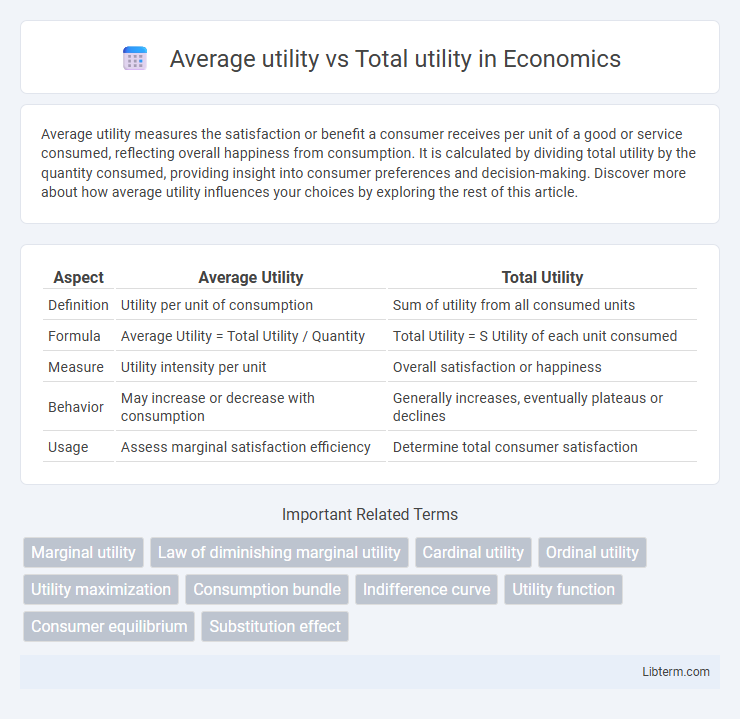Average utility measures the satisfaction or benefit a consumer receives per unit of a good or service consumed, reflecting overall happiness from consumption. It is calculated by dividing total utility by the quantity consumed, providing insight into consumer preferences and decision-making. Discover more about how average utility influences your choices by exploring the rest of this article.
Table of Comparison
| Aspect | Average Utility | Total Utility |
|---|---|---|
| Definition | Utility per unit of consumption | Sum of utility from all consumed units |
| Formula | Average Utility = Total Utility / Quantity | Total Utility = S Utility of each unit consumed |
| Measure | Utility intensity per unit | Overall satisfaction or happiness |
| Behavior | May increase or decrease with consumption | Generally increases, eventually plateaus or declines |
| Usage | Assess marginal satisfaction efficiency | Determine total consumer satisfaction |
Introduction to Utility in Economics
Total utility represents the overall satisfaction a consumer derives from consuming a certain quantity of goods or services, measured in utils. Average utility is the total utility divided by the number of units consumed, indicating the satisfaction per unit. Understanding the distinction between total and average utility helps analyze consumer behavior and decision-making in economics.
Defining Average Utility
Average utility measures the satisfaction gained per unit of a good or service consumed, calculated by dividing total utility by the quantity consumed. Total utility represents the overall satisfaction obtained from consuming a specific quantity of goods, whereas average utility reflects the efficiency or satisfaction derived from each individual unit. Understanding average utility helps in analyzing consumer choices and optimizing consumption to maximize satisfaction.
Understanding Total Utility
Total utility measures the overall satisfaction gained from consuming a specific quantity of goods or services, representing the cumulative benefit to the consumer. It continuously increases as consumption rises, but at a diminishing rate due to the law of diminishing marginal utility. Understanding total utility helps businesses and economists assess consumer behavior and optimize product offerings to maximize overall satisfaction.
Key Differences: Average Utility vs Total Utility
Average utility measures the satisfaction gained per unit of a good or service consumed, calculated by dividing total utility by the quantity consumed. Total utility represents the overall satisfaction or benefit derived from consuming a specific quantity of goods or services. The key difference lies in total utility reflecting cumulative satisfaction, while average utility indicates the efficiency or satisfaction level per unit consumed.
Calculation Methods for Each Utility
Average utility is calculated by dividing total utility by the quantity of goods consumed, expressed as AU = TU/Q, where TU represents total utility and Q is the quantity. Total utility measures the overall satisfaction obtained from consuming a given amount of goods, calculated by summing the marginal utilities of each unit consumed. Accurate calculation of average and total utility allows for effective analysis of consumer satisfaction and decision-making in microeconomics.
The Law of Diminishing Marginal Utility
Average utility measures the total satisfaction gained per unit of a good consumed, calculated by dividing total utility by the quantity consumed, while total utility represents the overall satisfaction from all units consumed. The Law of Diminishing Marginal Utility explains that as more units of a good are consumed, the additional satisfaction derived from each extra unit decreases, causing marginal utility to decline and eventually reducing the rate at which total utility grows. This principle underpins the difference between average and total utility by illustrating that total utility increases at a decreasing rate while average utility may initially rise but eventually falls with further consumption.
Practical Examples of Average and Total Utility
Total utility measures the overall satisfaction gained from consuming a certain quantity of goods, such as a customer enjoying 10 slices of pizza that yield a total utility of 80 utils. Average utility calculates satisfaction per unit, so in this case, the average utility is 8 utils per slice of pizza (80 utils divided by 10 slices). Practical examples include tracking how total utility increases with more consumption until saturation, while average utility often decreases as each additional unit provides less incremental satisfaction.
Importance in Consumer Choice Theory
Average utility measures the satisfaction gained per unit of a good consumed, while total utility represents the overall satisfaction from consuming all units. In Consumer Choice Theory, understanding average utility helps determine the optimal quantity of a good by comparing marginal benefits to costs, ensuring consumers maximize satisfaction. Total utility guides broader consumption patterns, reflecting the cumulative happiness derived from different combinations of goods.
Implications for Demand Curves
Average utility measures the satisfaction per unit consumed, while total utility represents overall satisfaction from all units consumed. Demand curves reflect consumer behavior where diminishing marginal utility causes total utility to rise at a decreasing rate, leading to a downward-sloping marginal utility and price relationship. This interplay explains why consumers buy less as prices increase, shaping the demand curve's negative slope.
Conclusion: Choosing the Right Utility Measure
Choosing the right utility measure depends on the decision context: average utility provides insight into the satisfaction per unit consumed, making it ideal for assessing the efficiency of resource allocation, while total utility captures overall satisfaction or happiness derived from all units consumed, offering a broader perspective on consumer well-being. For optimizing consumption choices, average utility is more relevant when resources are limited or when marginal changes matter, whereas total utility is beneficial for understanding cumulative effects and maximum achievable satisfaction. Aligning utility measurement with specific goals ensures more accurate and effective economic analysis and consumer decision-making.
Average utility Infographic

 libterm.com
libterm.com